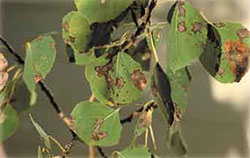
What is aspen leaf spot?
Aspens are susceptible to many problems in the urban landscape. One of those problems is aspen leaf spot, a disease caused by fungus. Aspen leaf spot, or Marssonina leaf spot, is common on aspen trees in the late summer and autumn. A previous spring of warm, rainy conditions creates the perfect environment for the disease to develop and spread.
What does aspen leaf spot look like?
When affected by the disease, black spots form on aspen leaves. However, black spots may develop for a variety of reasons, so it’s important to recognize all of the symptoms of aspen leaf spot. Symptoms occur between July and frost. Leaves affected with the disease will be scattered randomly throughout the tree and spots will appear randomly on the leaves. The spots are dark brown to black circles containing rings, looking almost like a bulls-eye. Sometimes the edges of the spots may appear irregular or feathery.
How can I prevent aspen leaf spot?

To manage aspen leaf spot, rake fallen leaves in the autumn to prevent the spread of the fungus in the spring. Aspen leaf spot is usually not severe enough to warrant the use of fungicide, but if the symptoms occur year after year, apply a product such as Daconil 2787 in the spring when leaves are emerging from the bud. It’s too late to apply fungicide once the symptoms are evident. Read and follow label directions carefully. Aspens are very sensitive to many pesticides. If applied incorrectly, pesticides can cause leaves to turn black.
For more information, see the following Colorado State University Extension fact sheet(s).



